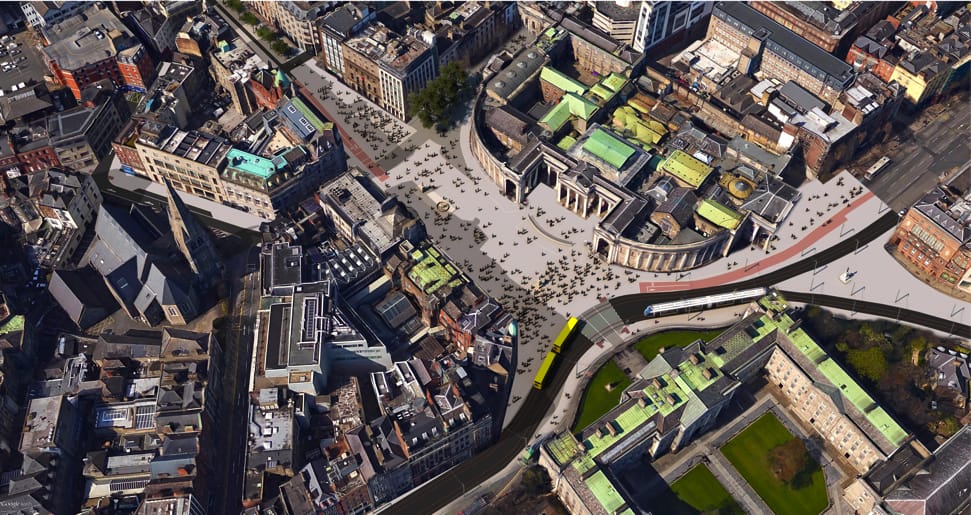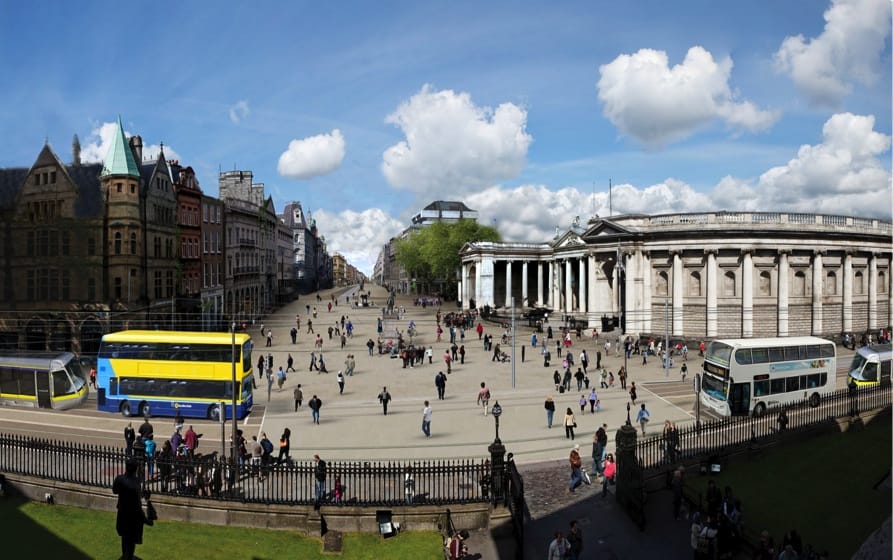What’s the best way to tell area residents about plans for a new asylum shelter nearby?
The government should tell communities directly about plans for new asylum shelters, some activists and politicians say.
Business associations, councillors, and cycling advocates all seem happy with plans for a grand sweeping plaza that aim to transform College Green into a glorious civic space.

When Dublin City Council first proposed the creation of a European-style plaza on College Green last year, as part of a package of changes to traffic to make way for the Luas, there were a few complaints.
The pedestrianised area was sat next to what looked like it could be fast-moving traffic. There were concerns about cyclists’ safety, as it looked like they’d share the road with buses. And several councillors objected to the plan to remove statues from the main thoroughfare.
The new proposal addresses these issues, and it looks like good news for pedestrians and cyclists. Right now, it’s unclear exactly what it will mean for bus routes — they’re still working that out.

If you haven’t seen the new design already, it shows a sweeping plaza that would cover an area from the front of the Bank of Ireland on Dame Street, and Foster Place, to the other side of the street.
There would be a strip for buses and the Luas to run along the front of Trinity College, up towards Lower Grafton Street, and left onto Nassau Street. If it happens, pedestrians will be able to walk all the way from Stephen’s Green to the South Quay.
So far, the reception from local councillors, transport watchers, and business associations, has been positive.
“This is a win-win for Dublin,” said the CEO of Dublin Chamber of Commerce, Gina Quin. “This is an exciting opportunity for the centre of Dublin and indicative of the multiple positive effects that large infrastructure investments can have on the city.”
Business group DublinTown also welcomed the plan in a statement, and said it seems workable, and is happy that access to public car parks and hotels has been maintained.
“Overall, we’re very happy with it,” said Colm Ryder, head of the Dublin Cycling Campaign on Tuesday. “Dublin needs a really big civic space, we need to be like so many other European cities and moving in this type of area as well.”
There were concerns last year that cyclists would end up caught between the two new Luas lines when trying to cross over from Trinity to College Green. The new design, however, proposes a two-way segregated cycle track that will run along the side of Bank of Ireland down Westmoreland Street, cross over the plaza, and continue onto Dame Street.
For pedestrians, the council also proposes a wide crossing point between the plaza and Trinity College, briefly interrupting the flow of the Luas and bus routes.
The new design means that cars will not be allowed on College Green. At the moment, it looks like Trinity Street and Church Lane are to be reversed to allow traffic to flow back onto that end of Dame Street and to facilitate loading vehicles near the plaza.
In December, a decision had yet to be made as to whether or not to allow taxis around College Green. Under the new design, taxis will be allowed to move alongside the Luas and buses for a trial period.
The statues of political campaigner Henry Grattan and writer Thomas Davis won’t be moved, which means that the council won’t have to go through a Part VIII planning procedure, as they had to under the previous plan.

Still to sort out, is the issue of where all the buses which currently travel down Dame Street each day, will be rerouted to. Dublin City Council, Dublin Bus, and the National Transport Authority are trying to work that out.
“What we’d be looking at doing is looking at which bus stops are affected,” said Brendan O’Brien, head of technical services on Monday at the council’s South-East Area Committee meeting. “We’d be looking at where new bus stops can be located and minimising the disruption to the services that are coming down this route.”
The proposal also highlights the potential to create four major bus corridors between the north and south inner-city areas, which would lead to more services on the quays.
The new design also proposes a major stop on College Green, at the corner of Dame Street and Grafton Street Lower to make the plaza more accessible for visitors and commuters.
“We’ve been working very closely with Dublin City Council since last summer,” said National Transport Authority spokesperson Sara Morris. “We’re not looking at specific routes just yet, we’re looking more at alignment as a whole.”
But the bus routes on George’s Street, which previously turned right down Dame Street are now likely to turn left up Dame Street and down Parliament Street onto to the quays, she said.
Dublin Bus says it “will continue to work proactively with Dublin City Council to ensure that bus routes which have been diverted to unsuitable alignments to facilitate Luas Cross City works are reinstated after construction”.
At the moment, there’s a blank area where the plaza goes. That’s because it will be up to a design team to work out exactly what that will look like — how the cycle track will run through it, whether there will be trees, and what public art might be featured.
Some councillors, like Kieran Binchy of Fine Gael, raised concerns regarding the railings in front of Bank of Ireland and Trinity College. If removed, they “would increase the public plaza and increase space”, he said.
Councillors Dermot Lacey of Labour and Paddy McCartan of Fine Gael both said they would love to see the old Parliament building back in public ownership.
Bank of Ireland didn’t give much away in its press statement, and didn’t respond to queries. It “notes the publication of the Dublin City Council proposals for College Green, and will participate in the upcoming consultation regarding same,” it said.
So what are the next steps in the plan?
The plan is up for a four-week public consultation in March, when you can let Dublin City Council know what you think of all the changes.
In the spring, an open procurement for an architecture design team will kick off, to select those who will design the plaza. The final appointment is due to be made by summer.
Any agreed changes are due to be put in place by mid-2017.